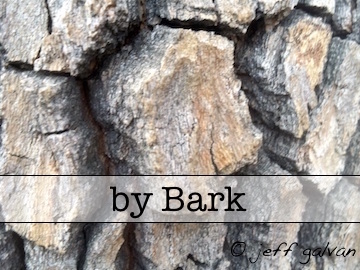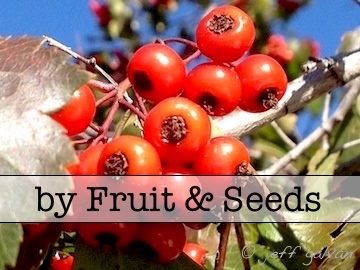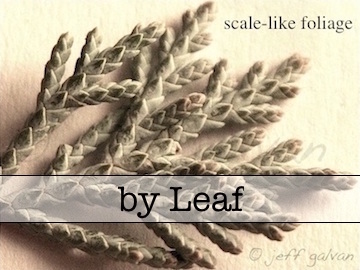Examine the details. A fragment of a hull or seed from last year, a dried leaf or piece of fruit hanging to a stem. We may rely on the over-all shape of the tree, branches and twigs or the smell of the wood. There may be thorns on the tree or other characteristics that give us a better understanding of which species we’re observing.
Tree Identification by Leaf
Is the leaf’s margin serrate or entire? Is it simple or compound? How wide and long are they? Are the leaves broad, flat leaves or do the look needle-like? What color are they? Do they have tiny hairs on the undersides? Rough or soft, shiny or dull? Do they have lobes? If so, how many and how deep? Do they grow opposite from one another, are they alternately arranged or whorled on the stem?
Tree Identification by Bark
 Tree Bark characteristics are used when trying to identifying trees, especially deciduous trees, year round. During the winter months after leaves have often blown away (although there are trees that hold onto their leaves until spring), buds may be dormant and hard to identify and the fruit, seeds and flowers might be long gone.
Tree Bark characteristics are used when trying to identifying trees, especially deciduous trees, year round. During the winter months after leaves have often blown away (although there are trees that hold onto their leaves until spring), buds may be dormant and hard to identify and the fruit, seeds and flowers might be long gone.
Study the texture, patterns and colors and notice if the bark is furrowed, smooth, peeling, flaking or take note of any other unique features. Are there large squares or chunky course pieces of aged grey bark falling away and revealing smooth bark? Is it thick or thin? Are there diamond patterns, does it look shaggy or fleshy? Is it orange, brown, grey or multiple colors?
Tree Identification by Flower
Flowers are a fantastic way of discovering what type of tree your studying. The challenging thing may be that they are often only present for such a short time of the year and on large trees they can difficult to obtain. There are many different types of tree flowers and by finding out more about the way their flowers are arranged will help ask the right questions (eg. maple flowers are called drooping racemes).
Identifying Fruits and Seeds
 Fruit is a very distinguishing tree characteristic. But, can you tell the difference between seven different kinds of apples or three different winged samaras just by looking at them? While describing the fruit you see may not tell you all you need to know to figure out what species the tree is, it sure does point you in the right direction. If you have the fruit with the bark and leaf, it’s likely it won’t take long to name the tree.
Fruit is a very distinguishing tree characteristic. But, can you tell the difference between seven different kinds of apples or three different winged samaras just by looking at them? While describing the fruit you see may not tell you all you need to know to figure out what species the tree is, it sure does point you in the right direction. If you have the fruit with the bark and leaf, it’s likely it won’t take long to name the tree.
By Twigs and Branches

Much in the same way bark can help you identify a tree, twigs and branches are useful in identifying a deciduous trees during the winter months. Are the branches in an alternate or opposite arrangement? Notice the leaf scars. Are they big or small? Are they concave or more convex? Do you see a terminal bud or is it absent?
Use the information you’ve gathered to look up the name by searching a tree guide specific to the location where the tree grows, by using a tree identification key or by viewing our image library.
Search: Botanical (scientific) and Common Names
While all these trees grow in different areas of Northern America, many are found throughout the world.
A
- Alder, Thinleaf
- Apple
- Apple, Crabapple
- Arborvitae, American
- Ash, Green
- Ash, White
- Aspen, Quaking
B
- Birch, European White
- Birch, River
- Birch, Western Water
- Boxelder
- Bristlecone Pine
- Buckeye, Ohio
- Bur oak
C
- Catalpa, Western
- Cedar, Eastern Red
- Cottonwood, Narrowleaf
- Cottonwood, Plains
- Chokecherry
- Coffeetree, Kentucky
D
E-F
- Elm, American
- Elm, English
- Elm, Siberian
- Fir, Subalpine
- Fir, Concolor or White
G-H
- Ginkgo
- Globe Willow
- Goldenraintree
- Hawthorn
- Horsechestnut
- Hackberry, Common
L-J
- Lilac, Common
- Linden, American
- Linden, Littleleaf
- Locust, Black
- Locust, Honey
- Locust, Idaho Flowering
- Locust, New Mexico
- London Plane
- Juniper, Rocky Mountain
- Juniper, Upright
- Juniper, Utah
M-O
- Mulberry
- Maple, Amur
- Maple, Norway
- Maple, Red
- Maple, Rocky Mountain
- Maple, Silver
- Maple, Sugar
- Mountainash, European
- Oak, Gambel
- Oak, Northern Red
- Oak, Swamp White
- Oak, Pin
P
- Pagodatree, Japanese
- Peach
- Pear, Callery
- Pine, Austrian
- Pine, Eastern White
- Pine, Limber
- Pine, Lodgepole
- Pine, Pinyon
- Pine, Ponderosa
- Pine, Scotch
- Plum, American
- Plum, Newport
- Poplar, Bolleana (White)
- Poplar, Lombardy
R
S
- Spruce, Colorado Blue
- Spruce, Engelmann
- Spruce, Norway
- Sumac, Smooth
- Sumac, Staghorn
- Sycamore, American
T
W
- Walnut, Black
- Willow, Peach Leaf
- Willow, Weeping
Proper tree identification can assist us when it comes to selecting a tree to plant, identifying edibles, researching possible illnesses and diseases or other problems associated with a specific type of tree. Over the years, I have been capturing photographs of trees in their different stages of development. The photographs and information about these trees is updated continually.


